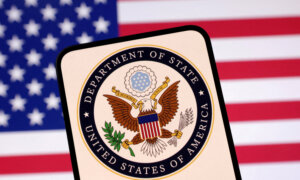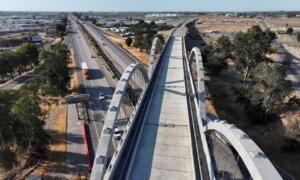American motorists and vacationers are hitting the roads and airports in higher-than-expected numbers during the ongoing spring break period.
In a statement provided to The Epoch Times, the Transportation Security Administration (TSA) said it expects high passenger volumes during the peak spring break travel period, which runs through the end of this week. Nationwide, spring break air travel numbers are expected to increase by more than 5 percent from last year.
On busy days so far this month, TSA has been screening 2.5 million to 2.7 million people per day nationwide.
“Spring break is one of the busiest travel times of the year,” said acting TSA director Adam Stahl. “While we are focused on spring break, the TSA is also closely tracking and preparing for the summer travel season.”
According to Airlines for America (A4A), the industry trade organization representing the leading U.S. carriers, the nation’s top airlines expect to carry 173 million passengers from March 1 to April 30—a 4 percent increase from the same period in 2024.
“To accommodate this demand, U.S. airlines will utilize more flights and more seats each day—up 5 percent and 3 percent, respectively, from last year,” A4A spokeswoman Marli Collier told The Epoch Times via email.
Beyond domestic airline travel, the International Air Transport Association (IATA) reiterated its forecast that global airline industry revenue will surpass $1 trillion for the first time in 2025, reaching $1.007 trillion. It also projects an expected net profit of $36.6 billion, despite ongoing challenges in the aircraft supply chain and tariff uncertainty.
While the TSA officials deal with heavy domestic and international traffic at U.S. airports, AAA data show that lower pump prices and electric vehicle (EV) charging rates are also incentivizing winter-weary travelers to hit the highways during the spring break and upcoming summer driving season. Currently, drivers are seeing posted pump prices in 31 states under $3.00 a gallon of regular unleaded, according to the AAA’s weekly fuel price report.
For this week, gasoline prices nationwide are averaging $3.12 a gallon as refineries switch over to the more expensive summer-blend of gasoline. That price is up $0.05 from a week ago, but $0.40 lower than a year ago, according to AAA data.
“This increase has nothing to do with politics or tariffs—which remain paused for now—but is instead the result of seasonality, and is something that happens almost every year,” Patrick De Haan, head of petroleum analysis at GasBuddy, told The Epoch Times.
The nation’s most expensive gasoline market is California ($4.66), which is generally higher due to the relatively few refineries that produce California’s unique reformulated gasoline blend. California’s tax on gasoline is also higher than the tax in most other states.
Other states with the highest pump prices include Hawaii ($4.54), Washington ($4.08), Nevada ($3.74), Oregon ($3.71), Alaska ($3.40), Arizona ($3.35), Illinois ($3.25), Pennsylvania ($3.23), and Idaho ($3.19).
The nation’s least expensive gasoline markets are all located in the Southeast, Southwest, or Midwest United States. In Mississippi, motorists are filling up a tank on average at $2.64 per gallon, following by Texas ($2.66), Kentucky ($2.68), Oklahoma ($2.71), Louisiana ($2.72), Tennessee ($2.73), Arkansas ($2.78), Alabama ($2.75), South Carolina ($2.76) and North Carolina ($2.78).
For those driving electric cars, the national average cost per kilowatt-hour of electricity at a public EV charging station remains unchanged at $0.34, according to AAA data.
The nation’s top 10 most expensive states for public charging per kilowatt hour are Hawaii ($0.56), West Virginia ($0.47), Montana ($0.45), Idaho ($0.43), South Carolina ($0.42), Tennessee ($0.42), Arkansas ($0.42), New Hampshire ($0.42), Kentucky ($0.41), and Alaska ($0.41).
The top 10 least expensive states for public charging per kilowatt hour are Kansas ($0.22), Missouri ($0.25), Nebraska ($0.26), Delaware ($0.29), Iowa ($0.29), Michigan ($0.29), North Dakota ($0.30), Utah ($0.30), and Texas ($0.30).
Once spring break travel wraps up at the end of this month, the TSA, the IATA, and the broader travel industry will begin to ramp up for the summer travel season in the United States, which typically starts on Memorial Day and runs through the Labor Day weekend.
AAA spokeswoman Aixa Diaz told The Epoch Times that although the travel industry group doesn’t monitor spring break travel trends, it does release its annual travel forecast ahead of the Memorial Day holiday.
A year ago, AAA estimated that 43.8 million vacationers traveled 50 miles or more from home during the Memorial Day holiday travel period. That was a 4 percent increase over the previous year and nearly matched the pre-pandemic record of 44 million Memorial Day travelers in 2005.














